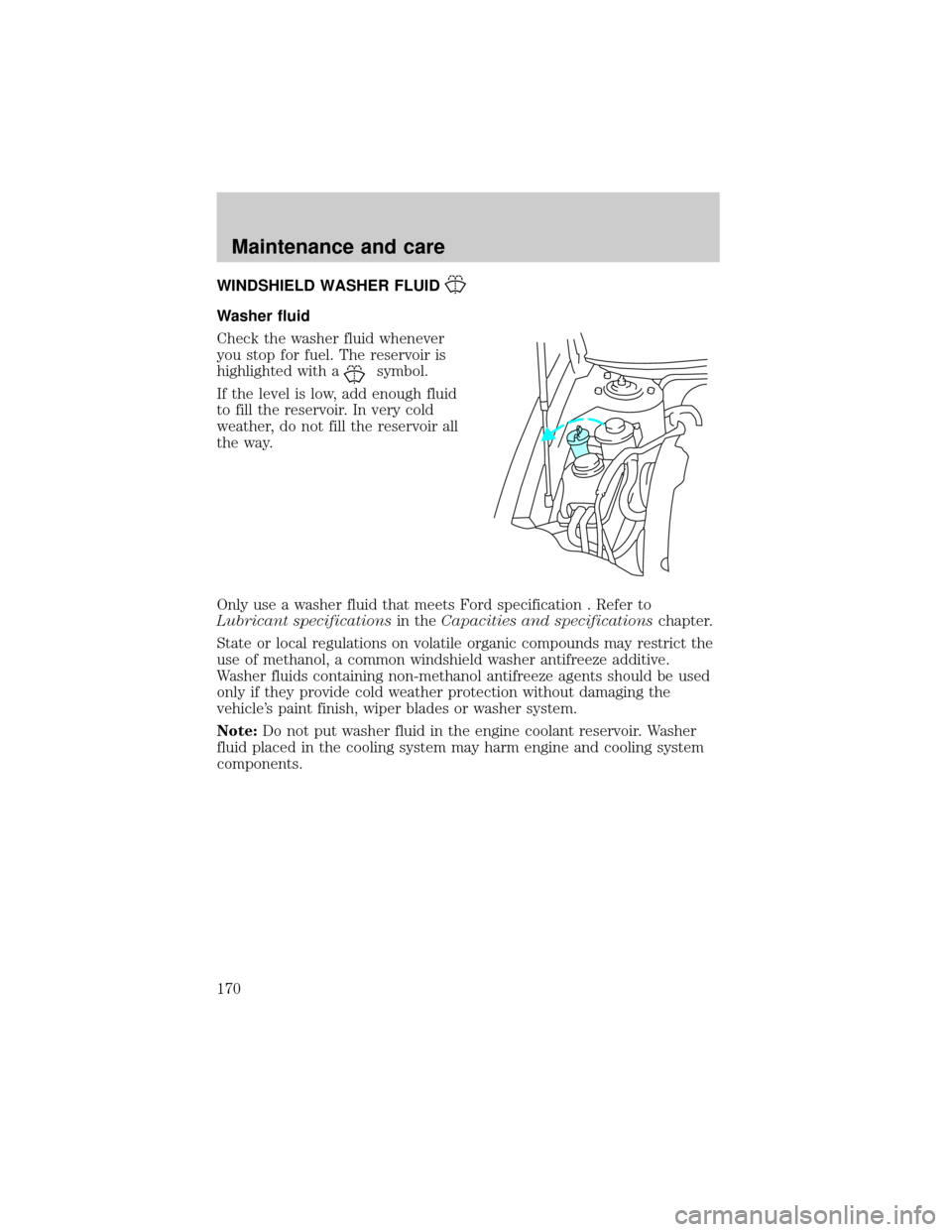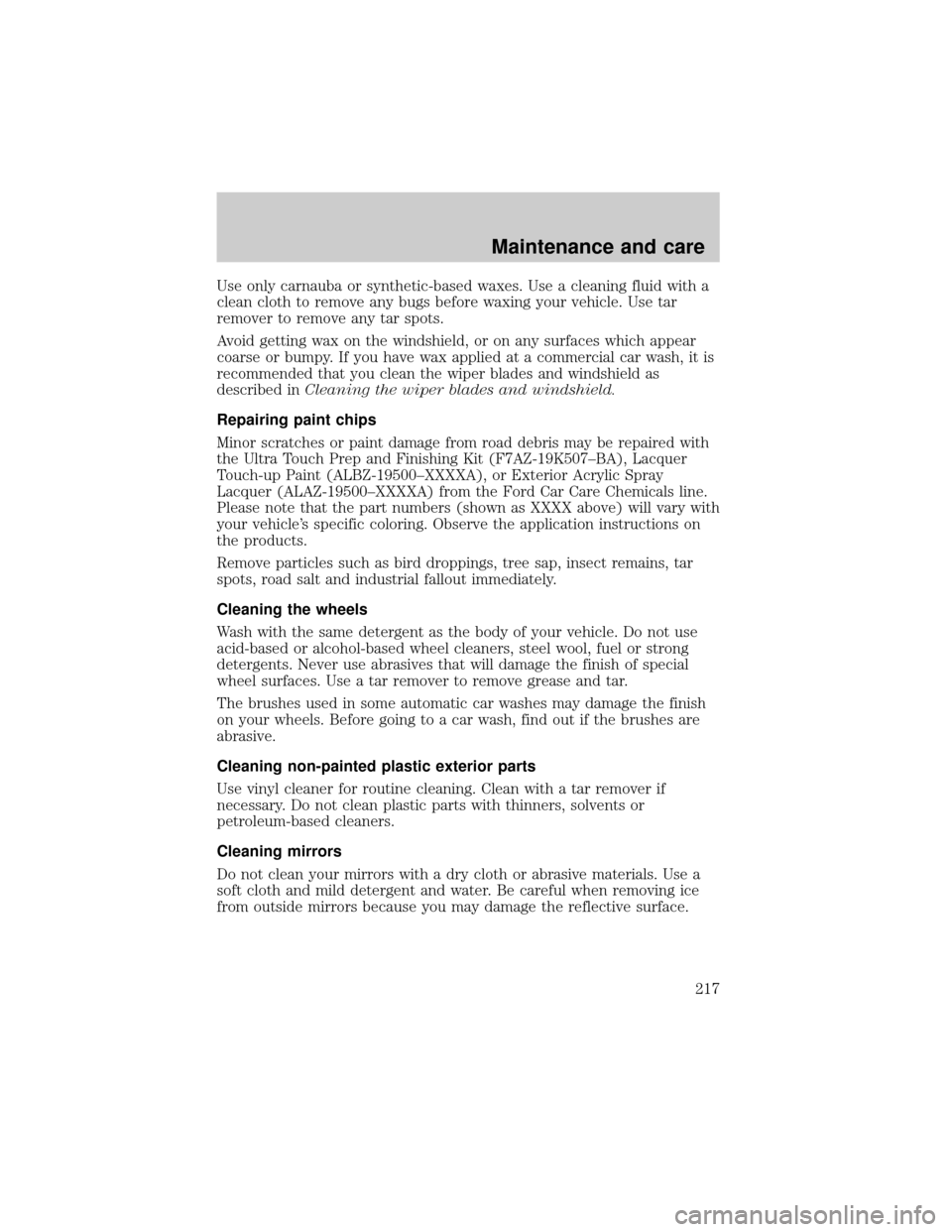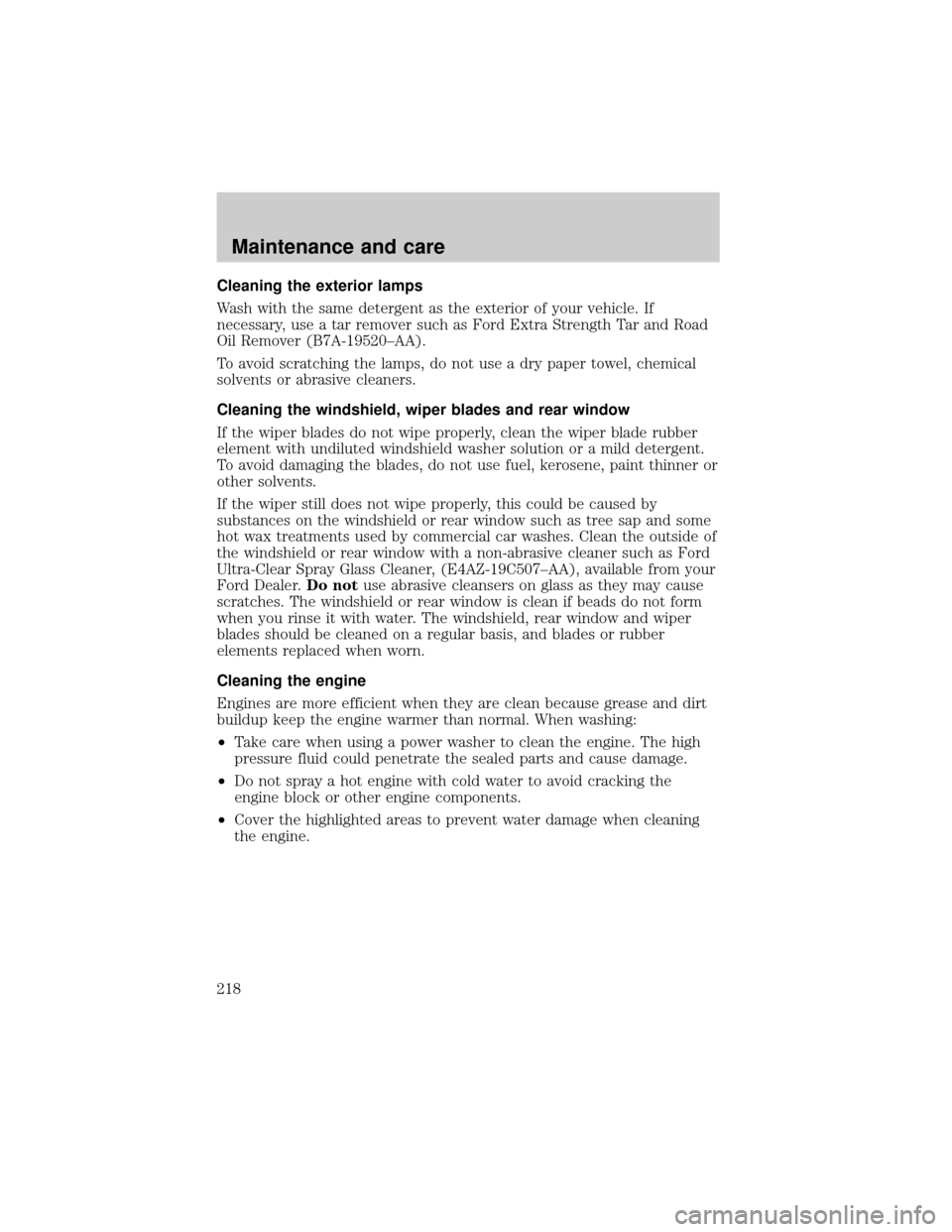2001 FORD TAURUS wiper fluid
[x] Cancel search: wiper fluidPage 170 of 256

WINDSHIELD WASHER FLUID
Washer fluid
Check the washer fluid whenever
you stop for fuel. The reservoir is
highlighted with a
symbol.
If the level is low, add enough fluid
to fill the reservoir. In very cold
weather, do not fill the reservoir all
the way.
Only use a washer fluid that meets Ford specification . Refer to
Lubricant specificationsin theCapacities and specificationschapter.
State or local regulations on volatile organic compounds may restrict the
use of methanol, a common windshield washer antifreeze additive.
Washer fluids containing non-methanol antifreeze agents should be used
only if they provide cold weather protection without damaging the
vehicle's paint finish, wiper blades or washer system.
Note:Do not put washer fluid in the engine coolant reservoir. Washer
fluid placed in the cooling system may harm engine and cooling system
components.
Maintenance and care
170
Page 217 of 256

Use only carnauba or synthetic-based waxes. Use a cleaning fluid with a
clean cloth to remove any bugs before waxing your vehicle. Use tar
remover to remove any tar spots.
Avoid getting wax on the windshield, or on any surfaces which appear
coarse or bumpy. If you have wax applied at a commercial car wash, it is
recommended that you clean the wiper blades and windshield as
described inCleaning the wiper blades and windshield.
Repairing paint chips
Minor scratches or paint damage from road debris may be repaired with
the Ultra Touch Prep and Finishing Kit (F7AZ-19K507±BA), Lacquer
Touch-up Paint (ALBZ-19500±XXXXA), or Exterior Acrylic Spray
Lacquer (ALAZ-19500±XXXXA) from the Ford Car Care Chemicals line.
Please note that the part numbers (shown as XXXX above) will vary with
your vehicle's specific coloring. Observe the application instructions on
the products.
Remove particles such as bird droppings, tree sap, insect remains, tar
spots, road salt and industrial fallout immediately.
Cleaning the wheels
Wash with the same detergent as the body of your vehicle. Do not use
acid-based or alcohol-based wheel cleaners, steel wool, fuel or strong
detergents. Never use abrasives that will damage the finish of special
wheel surfaces. Use a tar remover to remove grease and tar.
The brushes used in some automatic car washes may damage the finish
on your wheels. Before going to a car wash, find out if the brushes are
abrasive.
Cleaning non-painted plastic exterior parts
Use vinyl cleaner for routine cleaning. Clean with a tar remover if
necessary. Do not clean plastic parts with thinners, solvents or
petroleum-based cleaners.
Cleaning mirrors
Do not clean your mirrors with a dry cloth or abrasive materials. Use a
soft cloth and mild detergent and water. Be careful when removing ice
from outside mirrors because you may damage the reflective surface.
Maintenance and care
217
Page 218 of 256

Cleaning the exterior lamps
Wash with the same detergent as the exterior of your vehicle. If
necessary, use a tar remover such as Ford Extra Strength Tar and Road
Oil Remover (B7A-19520±AA).
To avoid scratching the lamps, do not use a dry paper towel, chemical
solvents or abrasive cleaners.
Cleaning the windshield, wiper blades and rear window
If the wiper blades do not wipe properly, clean the wiper blade rubber
element with undiluted windshield washer solution or a mild detergent.
To avoid damaging the blades, do not use fuel, kerosene, paint thinner or
other solvents.
If the wiper still does not wipe properly, this could be caused by
substances on the windshield or rear window such as tree sap and some
hot wax treatments used by commercial car washes. Clean the outside of
the windshield or rear window with a non-abrasive cleaner such as Ford
Ultra-Clear Spray Glass Cleaner, (E4AZ-19C507±AA), available from your
Ford Dealer.Do notuse abrasive cleansers on glass as they may cause
scratches. The windshield or rear window is clean if beads do not form
when you rinse it with water. The windshield, rear window and wiper
blades should be cleaned on a regular basis, and blades or rubber
elements replaced when worn.
Cleaning the engine
Engines are more efficient when they are clean because grease and dirt
buildup keep the engine warmer than normal. When washing:
²Take care when using a power washer to clean the engine. The high
pressure fluid could penetrate the sealed parts and cause damage.
²Do not spray a hot engine with cold water to avoid cracking the
engine block or other engine components.
²Cover the highlighted areas to prevent water damage when cleaning
the engine.
Maintenance and care
218
Page 244 of 256

Child safety seats ......................114
attaching with tether straps ..118
in front seat ............................115
in rear seat ......................115, 118
LATCH .....................................120
Cleaning your vehicle ...............216
engine compartment ..............218
exterior ............................216±217
exterior lamps .........................218
instrument cluster lens ..........220
instrument panel ....................220
interior .............................220±221
mirrors .....................................217
plastic parts ............................217
safety belts ..............................221
washing ....................................216
waxing .....................................216
wheels ......................................217
windows ..................................220
wiper blades ............................218
woodtone trim ........................220
Climate control (see Air
conditioning or Heating) ............19
Clock ................................33, 40, 46
Console ........................................65
Controls
power seat .................................86
Coolant
checking and adding ..............171
refill capacities ................175, 223
specifications ..................224, 226
Cruise control (see Speed
control) ........................................53
Customer Assistance ................144
Ford accessories for your
vehicle .....................................237
Ford Extended Service
Plan ..........................................230Getting assistance outside the
U.S. and Canada .....................236
Getting roadside assistance ...144
Getting the service
you need .................................230
Ordering additional owner's
literature .................................240
The Dispute Settlement
Board .......................................233
Utilizing the
Mediation/Arbitration
Program ...................................236
D
Daytime running lamps (see
Lamps) .........................................17
Defrost
rear window ..............................18
Dipstick
automatic transmission fluid .178
engine oil .................................166
Doors
door ajar warning .......................9
lubricant specifications ..........224
Driving under special
conditions
through water .........................138
E
Emergencies, roadside
jump-starting ..........................156
Emission control system ..........202
Engine ........................................226
check engine/service engine
soon light ..................................10
cleaning ...................................218
coolant .....................................171
Index
244
Page 248 of 256

Servicing your vehicle ..............162
Spark plugs,
specifications .....................222, 226
Specification chart,
lubricants ...........................224, 226
Speed control ..............................53
Speedometer ...............................14
Starting your vehicle ........122, 124
jump starting ..........................156
Steering wheel
tilting .........................................58
T
Tachometer .................................15
Tires ...........................152, 188±190
changing ..........................152±153
checking the pressure ............190
replacing ..................................191
rotating ....................................190
snow tires and chains ............191
tire grades ...............................189
treadwear ................................189
Towing .......................................139
recreational towing .................142
trailer towing ..........................139
wrecker ....................................161
Traction control ..................52, 130
active light ..................................8
Transaxle
automatic operation ...............132
fluid, refill capacities ..............223
lubricant specifications ..........226
Transmission
fluid, checking and adding
(automatic) .............................178lubricant specifications ..........224
Trip odometer .............................16
Trunk .........................67, 69, 71, 83
remote release ..........................66
Turn signal ..............................8, 56
V
Vehicle dimensions ...................226
Vehicle Identification Number
(VIN) ..........................................229
Vehicle loading ..........................137
Ventilating your vehicle ...........126
W
Warning chimes .....................13±14
Warning lights (see Lights) .........8
Washer fluid ..............................170
Water, Driving through .............138
Windows
power .........................................62
rear wiper/washer .....................57
Windshield washer fluid and
wipers
checking and adding fluid .....170
checking and cleaning ....187±188
liftgate reservoir .....................171
operation ...................................56
replacing wiper blades ...........188
Wrecker towing .........................161
Index
248